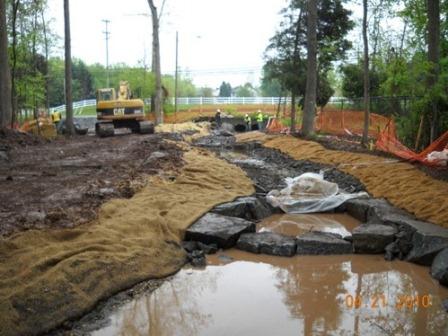 Restoring the stream aims to thwart bank erosion and stop trash from heading downstream.
Restoring the stream aims to thwart bank erosion and stop trash from heading downstream.
On paper, this project is described as “The Peyton Run at Longwood Knolls project,” located between Bestwicke Road and Lee Chapel Road. It is a Fairfax County Stormwater Planning project that involves retrofitting an existing stormwater detention basin to create a constructed wetland. This is “restoring” approximately 2,841 linear feet, more than half a mile, of eroded stream channel using natural channel design techniques, the county said. This work includes addressing a large bank failure which poses a safety hazard to the adjacent residential community and contributes excessive sediment downstream.
The county said the project, scheduled to be completed next summer, will improve water quality, restore the ecological function of the stream, improve instream habitat, and create a sustainable and safe stream valley.
 his Fairfax County picture shows what a typical stream restoration entails. Opponents say this is the wrong way to manage local streams.
his Fairfax County picture shows what a typical stream restoration entails. Opponents say this is the wrong way to manage local streams.
The county’s streams are getting overloaded by increased runoff due to all the streets, parking lots and sidewalks that are in Fairfax County, impervious surfaces. When it rains, the rainfall doesn’t soak into the ground in those areas, so there is much runoff, and it ends up in the streams, eroding the banks at a higher level then it would have if it soaked into the soil. The engineers of the county’s Soil and Water Conservation District are trying to lessen the impact of this runoff, which not only causes erosion, but carries trash, and toxic materials from the roads that harms the stream wildlife.
In 2003, Fairfax County embarked upon a long-term project to develop comprehensive Watershed Management Plans for each of the county’s watersheds. According to the county, there are 30 major watersheds – such as Accotink Creek, Difficult Run and Bull Run, in the western part of the county, and Long Branch. Wakefield Run and Kingstowne Stream in the eastern part. The 30 watersheds contain 980 miles of streams that all drain to the Potomac River and Chesapeake Bay.
Is It Enough?
The Environmental Protection Agency thinks these restoration methods may lack in nutrient retention, and still may be letting too many harmful chemicals get to the Chesapeake Bay.
EPA ecologist Paul Mayer has been involved, and he found the amounts of reactive nitrogen and phosphorus may be a problem. He found that a technique called regenerative stormwater conveyance triggers filtration by routing stream flow over a series of shallow pools lined with substrates of permeable sand overlying a mixture of organic materials such as wood chips. This may be limited though, and each stream has its own characteristics.
"What they found is that regenerative stormwater conveyance can be an important choice for stormwater management and a best management practice for nutrient reduction — but does not offer a one-size-fits-all approach across the watershed," the EPA said.
Is It Right?
Opponents of natural channel design techniques (see the photo above) say that it is detrimental to local streams, leads to removal of thousands of trees that are critical to the ecosystem, and fails to address the problem of stormwater runoff. Stormwater control should be done by non-destructive practices outside of streams, they say.
“Natural channel design is mainly applicable to large order streams and rivers, especially the kinds one finds in the American west,” wrote 10 concerned scientists and environmental advocates last year. “Applying it to small order, upper headwater stream channels of the deeply dissected Fall Zone of our area is a misuse of the methodology, ... and an unacceptable loss of irreplaceable native forest, wildlife, and landscape memory.” http://www.connectionnewspapers.com/news/2020/sep/26/opinion-letter-editor-wrong-approach-stream-restor/
